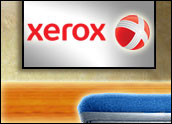
The “razors and razor blade” analogy is always the first to be employed when analysts — or technology reporters — begin their discussions of the copier/printer business. If you’re HP or Xerox, you sell the machine once, but you really make your money supplying customers with ink cartridges, toner and other supplies during the life of that machine.
That’s why the new ColorQube 9200 office printer, announced Thursday by Xerox, could be a significant development in the industry. Its solid ink printer technology can cut the cost of color printing by 62 percent, Xerox claims, and it’s also easier on the environment, thanks to less packaging and materials used.
That’s two shades of green for potential customers — less money spent and less damage to nature — and it’s a potent combination these days, according to Pund-IT analyst Charles King.
“Xerox is working very hard to re-establish themselves as the leader, or a major leader, in a field which they originated,” King told TechNewsWorld. “This could shake things up with the competition, particularly with HP.”
Bringing the Heat to Color Printing
The ColorQube technology represents an advance in solid ink technology that’s been used in Xerox’s desktop printers for about 10 years. It uses blocky, crayon-like sticks of solid ink that are placed in the printer and then heated. The molten ink flows onto the paper at faster speeds, says Xerox — speeds approaching 150 million drops per second, or 85 pages per minute. The ink sticks don’t need as much packaging, saving landfills and recycling facilities, and the company claims that using solid ink instead of laser printing cuts down on greenhouse gases used by 10 percent.
The technology also allows Xerox to offer a three-tiered pricing plan for those companies that prefer to pay for their printing by the page, according to the printer maker. Those companies pay for how much color ink is used; very little color on a page would result in black-and-white printing charges instead of a uniform color rate.
For companies that would spring for the cost of a $23,500 multifunction ColorQube printer, there’s still some potential savings, King said. “You may pay tens of thousands of dollars for a given printer, but again, when you’re multiplying the typical number of copies that a printer in an enterprise will print over the course of its life, and the fact that a business is paying a specific amount for each one of those copies, reducing the ink costs by some 62 percent can add up to a pretty tidy sum.”
Will ColorQube Make HP See Red?
Xerox’s ColorQube gauntlet thrown at HP could have some impact. “Not only is it a very innovative approach with technology, and very green, but this really hits HP where it lives,” King said. “HP’s profits and well-being are based on the printer business, and making sure those ink cartridges stay filled and ready for action. Xerox has a strong brand in corporate printing anyway, and if they come up with technology that’s not only more ecologically friendly but also significantly cheaper than what companies are used to, this could shake things up.”
With any new technology, the unexpected can happen. For example, King is curious to know if the quality of the color on the page would be the same as with a heavy-duty laser printer, and whether that color would fade over time.




















































Xerox came out with solid ink printing years ago – they have been using it in the "Phaser" line or solid ink printers. This is simply a consumer version, and while the ink itself is cheaper, something new that a consumer is going to need to learn to live with is having to occasionally buy oil. (The drum needs to be oiled before the waxy ink can be laid on it.)
When Xerox bought Techtronix with it came their "solid" (Crayon) ink technology which I had in a monster sized printer in 1989. So the technology is not new, and if it’s so good, cost effective and green why then was Techtronix in a position to be bought. One would think that would have made TT a major player. The one thing that I really remember is prints look like crayon and scraps off just as easily. AND the machine took forever to heat up, eating $$$ in power.
Xrocks is just recycling old technology claiming it as new"er". Ya know the analogy: lipstick (wax), pigs and stuff?
The funny thing is that I have a Techtronix Laser (toner) printer that I use now and it’s pretty good. So if this new"er" technology is so great why then is there still toner machines coming out of Xrocks/TT?